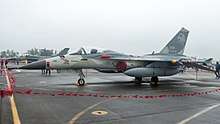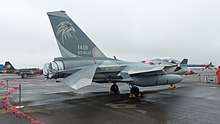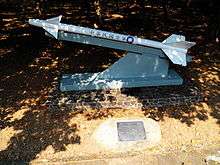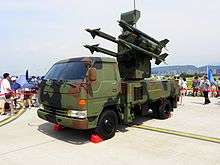Sky Sword
Sky Sword (Chinese: 天劍, Tien Chien) are a series of missile systems developed by the National Chung-Shan Institute of Science and Technology in Taiwan for the Republic of China Air Force (ROCAF).[1]


Sky Sword I (TC-I)


Sky Sword 1 (Chinese: 天劍一, Tien Chien I) is a short range infrared guided air-to-air missile. The missile has fire and forget slave-by-radar capabilities. It consists of an imaging infrared seeker, a high explosive warhead, a solid propellant motor and a guidance control unit.[2] The seeker uses dual spectral IR and has a detection range of 18.5km.[3] The Sky Sword 1 is also used as a surface-to-air missile by the Antelope air defence system.[4][5]
Development
Sky Sword 1 (TC-1) missile was developed in the mid-1980s and revealed in May 1986, as Taiwan's first indigenous air-to-air missile.[1] The production of the missile started in 1991 and the air-to-air version entered ROCAF service in 1993. It bears a striking similarity to the American AIM-9 (also in Taiwanese service) and fulfills a similar role on the Indigenous Defense Fighter to the AIM-9 on the F-16. In 2017 NCSIST exhibited a variant of the TC-1 with a larger diameter motor.[6]
Service history
TC-1 missiles were employed during a 2019 training exercise off Taiwan’s east coast.[7]
Variants
TC-1L
Ground launched variant for use with Antelope air defence system.[8]
Sky Sword 2 (TC-II)

Sky Sword II (天劍二, Tien Chien II) is a medium-range, radar guided air-to-air missile. It has an inertial navigation system, a data-link for mid-course guidance and active radar homing for terminal guidance, beyond visual range. It also has ECCM capability and can engage multiple targets.[10] According to Su Tzu-yun, Chief Executive Officer at the Center for Advanced Technology at Tamkang University, they are a cost-effective design which can perform a key role in Taiwan's defense strategy, and substantially offset China’s air superiority.[11] Some details of its design were revealed for the first time at the Paris Air Show in 2015.[12] The pulse doppler radar seeker reportedly has a detection range of 9.3km.[13]
Service history
In 2017 a Sky Sword II launched by a F-CK-1 during a training exercise failed to ignite and fell into the sea.[14] In 2019 TC-1 and TC-2 models were among 117 missiles fired during a training exercise off Taiwan’s west coast.[15]
Variants
TC-2N
A ship-launched, surface-to-air version was later developed and designated TC-2N. It began development in 1994, and a ground-based test was first carried out against a low-flying drone in 1997. This development was revealed to the public in 2005 and the intention to make it compatible with vertical launch methods was later announced in 2006. The first ship-based launch was held in mid 2014.[16] In the naval role the TC-2N fills an air defense gap between the Phalanx CIWS and SM-2 systems[17] and with a range of 30km.[18]
The missile has all-weather capability, is equipped with a thrust-vectoring booster to increase its range as well as maneuverability during launch phase (although early ship-based launch trials were carried out without this feature), and can engage anti-ship missiles and aircraft. It also has folding control surfaces to be quad-packed into either above-deck oblique launchers or in-deck vertical launch systems.[16]
TC-2A
TC-2A is an anti-radiation missile, similar to US AGM-88 HARM. The TC-2A program began soon after the completion of the TC-2. It fills the requirement of the ROCAF for an Anti-Radiation Missile to arm the F-CK-1.[19] It is reported to be 3.593 meters long, 19 cm in diameter, weighs 184 kg (warhead weighs 22 kg), and with a range of 100 km. The passive radar seeker on the TC-2A has been reported as having a detection range of 92km.[20]
TC-2C
TC-2C is an advanced air-to-air version first tested in 2017 and intended to replace the standard TC-2. It features a number of incremental improvements including an improved rocket motor which allows an engagement range of 100km.[21]
Surface-to-Air TC-2
The land based version of the TC-2N features the missile packaged in a sealed container-launcher.[22] NCSIST has exhibited a truck mounted version with four missile pods.[23] The TC-2 air-defense system was exhibited at International Defence Exhibition in Abu Dhabi with a reported canister length of 4m and an all up weight (combined canister and round) of 350kg. It reportedly has midcourse inertial guidance with data link and terminal active radar guidance and electronic counter-countermeasure (EECM) and protection, but a reported effective range of only 15km.[24]
Six batteries with 246 missiles were ordered in 2019.[25]
See also
Similar weapons (TC-1 and variants)
Similar weapons (TC-2 and variants)
References
- Jane's Weapon Systems. F. Watts. 1987.
- "NCSIST". www.ncsist.org.tw. Retrieved 2017-02-12.
- "IR Seeker (Sky Sword I)". cmano-db.com. CMANO. Retrieved 1 August 2019.
- http://missiledefenseadvocacy.org/air-defense/air-defense-of-u-s-partners/allied-air-defense-systems/the-antelope/
- https://www.armyrecognition.com/taiwan_taiwanese_missile_vehicle_system_uk/antelope_tien_chien_1_tc-1_surface-to-air_defense_missile_system_technical_data_sheet_specifications.html
- Cheng Jiawen, Hong Zhe Zhengyi. "國造海劍羚艦對空飛彈 預計111年服役". udn.com. UDN. Retrieved 8 May 2019.
- Evelyn Kao, Matt Yu and. "Taiwan holds live-fire drill along east coast". focustaiwan.tw. Focus Taiwan. Retrieved 1 August 2019.
- "Antelope Air Defense System". www.ncsist.org.tw. National Chung Shan Institute of Science and Technology. Retrieved 1 April 2019.
- Minnick, Wendell. "Taiwan Defense Show Exhibits New Weapons". www.defensenews.com. Defense News. Retrieved 1 April 2019.
- "NCSIST". www.ncsist.org.tw. Retrieved 2017-02-12.
- "Redefining Taiwan's air defense - Taipei Times".
- "Weapons institute releases new video to be aired at Paris show - Politics - FOCUS TAIWAN - CNA ENGLISH NEWS".
- "Active Radar Seeker (AAM MR, Sky Sword II)". cmano-db.com. CMANO. Retrieved 1 August 2019.
- Claudia Liu, Elaine Hou and. "Air Force reports another missile glitch". focustaiwan.tw. Focus Taiwan. Retrieved 21 July 2019.
- Everington, Keoni. "Taiwan fires over 100 missiles during China war drills". www.taiwannews.com.tw. Taiwan News. Retrieved 1 August 2019.
- "NCSIST". www.ncsist.org.tw. Retrieved 2017-02-12.
- "Tien Chien-2N (TC-2N)". missiledefenseadvocacy.org. Missile Defense Advocacy Alliance. Retrieved 24 July 2019.
- "Surface-to-Air TC-2 Mid-range Air-defense Missile". http://www.ncsist.org.tw/eng/csistdup/main/Default.aspx. National Chung-Shan Institute of Science & Technology. Retrieved 2019-10-22. External link in
|website=(help) - Hsu, Brian. "Report says military developing new missile". taipeitimes.com. Taipei Times. Retrieved 1 April 2019.
- "Passive Radar Seeker (Sky Sword IIA)". cmano-db.com. CMANO. Retrieved 1 August 2019.
- Lo Tien-pin and, Jonathan Chin. "Extended-range missiles ready for use". www.taipeitimes.com. Taipei Times. Retrieved 1 April 2019.
- "Taiwan develops new TC-2 short-range tactical air-defence system". defence-blog.com. defence-blog.com. Retrieved 2 April 2019.
- "Land-Based Air Defense Missile System". ncsist.org.tw. NCSIST. Retrieved 2 April 2019.
- "IDEX 2019: Land-based TC-2 air defense missile system by NCSIST". armyrecognition.com. Army Recognition. Retrieved 15 June 2019.
- Zhezheng, Hong. "Army purchases Chinese Academy of Sciences Sword II land-fired air defense missile vehicle". udn.com. Retrieved 19 January 2020.
External links
- TC-2 info on Global Security
- TC-2N test video:

_Logo.svg.png)